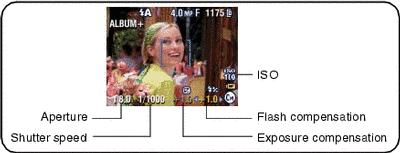Kodak EasyShare Z730 zoom digital camera — User's guide
Table of Contents >
Taking pictures and videos > Using P, A, S, M, and C modes
2 Taking pictures and videos

|
|

|
Aperture
- also known as f-stop, controls the size of the lens opening. (This determines the depth of field.) The highest and lowest aperture settings may be affected by optical zoom.
|
Aperture (f)
|
Depth of field
|
|
Larger f number (smaller lens opening)
|
Makes both the foreground and the background sharp. Good for landscapes and well-lit conditions.
|
|
Smaller f number (larger lens opening)
|
Makes the foreground sharp and the background blurry. Good for portraits and low-light conditions.
|
Shutter speed
- controls how long the shutter stays open. A shaking hand icon  warns of slow shutter speeds. (To prevent camera shake, use a tripod.) warns of slow shutter speeds. (To prevent camera shake, use a tripod.)
Exposure Compensation
- controls how much light enters the camera. Add or subtract up to 2 EV in 0.3 EV steps. If the picture is too light, decrease the setting; if it's too dark, increase the setting.
Flash Compensation
- controls the flash brightness (brighter: +0.5, +1.0; less bright: -0.5, -1.0). You must be within flash range. Unavailable if flash setting is Off.
ISO
- controls sensitivity of the camera sensor (80, 100, 200, 400, 800). Higher settings are more sensitive to light, but may produce unwanted "noise" in a picture. You can only use ISO 800 if you are in the 1.8 MP Picture Size setting. (See .)
|
Settings apply only in P, A, S, M, and C modes
Settings you change in P, A, S, or M modes apply only to pictures taken in P, A, S, and M modes. Settings you change in C mode apply only to pictures taken in C mode.
For example, if you change the Color Mode to Sepia while in P, A, S, or M mode, then Auto & Scene modes retain the default setting of Color.
| NOTE: |
The settings, including Flash, are maintained for P, A, S, M, and C modes—even when you change modes or turn off the camera. Use Reset to Default (see ) to reset P, A, S, M, or C mode to its default setting. |
Previous
Next


 warns of slow shutter speeds. (To prevent camera shake, use a tripod.)
warns of slow shutter speeds. (To prevent camera shake, use a tripod.)